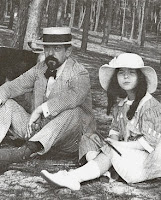 |
| My garden in the snow |
When wondering about what I would post today, I thought it would be fitting to write about the seasons in music. Many composers chose the natural world as compositional inspiration, and for some, they turn out to be some of their most well-known pieces. For instance, Reade portrays 'Spring' and 'Summer' in his 'Victorian Kitchen Garden Suite', as well as Chopin's interpretation of rain in his 'Raindrop' Prelude and Debussy's in 'Garden's in the Rain', as well as Delius' glorious 'Summer Evening'.
 |
| Above: Claude Debussy 1862 - 1918 Right: Debussy and Claude-Emma |
 Published in 1908, Debussy's Children's Corner is one of my favourite piano works. All six pieces were created in dedication to his daughter, Claude-Emma, and were inspired by the aspects of childhood and the dolls in her toy collection. Debussy had an incredible talent for creating colour in his orchestral music, with a technique that Arnold Schoenberg later described as, 'klangfarbenmelodie'. In his piano music, he had a similar skill. Thanks to Debussy's remarkable colour effects, in 'The Snow is Dancing' the sounds manage to describe snow - not rain - and the images seen through it. However, what I believe makes this piece especially beautiful is the writing for both hands. Debussy uses a semi-detatched part in both left and right hand which creates a melody between them. This is what I call great piano writing.
Published in 1908, Debussy's Children's Corner is one of my favourite piano works. All six pieces were created in dedication to his daughter, Claude-Emma, and were inspired by the aspects of childhood and the dolls in her toy collection. Debussy had an incredible talent for creating colour in his orchestral music, with a technique that Arnold Schoenberg later described as, 'klangfarbenmelodie'. In his piano music, he had a similar skill. Thanks to Debussy's remarkable colour effects, in 'The Snow is Dancing' the sounds manage to describe snow - not rain - and the images seen through it. However, what I believe makes this piece especially beautiful is the writing for both hands. Debussy uses a semi-detatched part in both left and right hand which creates a melody between them. This is what I call great piano writing.
I completely agree. It's as if he starts by describing the snow - just the snow-, and gradually reveals to us what else there is and how everything else is seen in contrast with and through the snow.
ReplyDelete